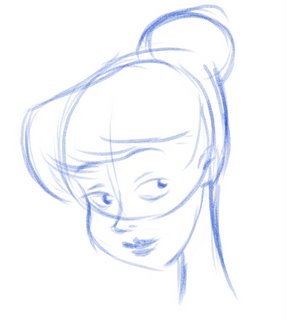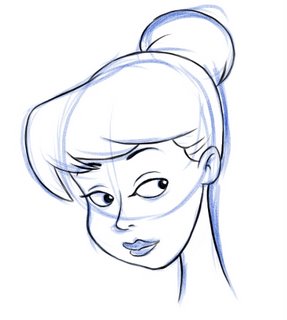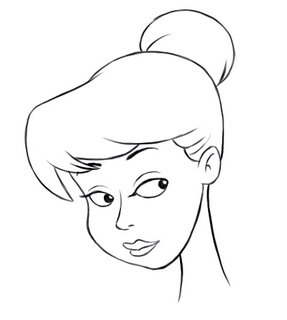Clean up or Screw up?
 I have had a request to post about my "philosophy" on cleanup. I will be writing about clean up for animation but this could be applied to any sort of drawing cleanup. First off let's look at what the job of cleanup is for. Getting the animation ready for paint is the main function of clean up. It is also a way of giving a consistency to the characters in the film. When approaching a clean line you must first understand how the animator has approached the scene. If by talking to the animator or if the animator is you the action needs to flow and there needs to be an understanding of why a line is were it is as well as which line might be the right one. You are drawing shapes not single lines. Every line you put down needs to help define something on the screen.
I have had a request to post about my "philosophy" on cleanup. I will be writing about clean up for animation but this could be applied to any sort of drawing cleanup. First off let's look at what the job of cleanup is for. Getting the animation ready for paint is the main function of clean up. It is also a way of giving a consistency to the characters in the film. When approaching a clean line you must first understand how the animator has approached the scene. If by talking to the animator or if the animator is you the action needs to flow and there needs to be an understanding of why a line is were it is as well as which line might be the right one. You are drawing shapes not single lines. Every line you put down needs to help define something on the screen. Often I have found cleanup artists who just "trace" over the animators drawings without observing if the character is on model. The problem here is you can lose a consistency to the film. An animators concerns are with getting the action, acting and expressions. The clean up artists concerns are with bringing those factors to the screen. I was once told by Eric Larson, "a clean up artist can kill, in one stroke, what took you hours to put down on paper". This was in response to my question to him on how an animator can be sure anyone who do follow up work on a scene will do exactly what you wanted. He went on to say that it's up to the animator to provide as much information as possible without going overboard. This is why if you ever see a completed rough scene there are sometimes partial drawings. These drawings show particular actions that may differ from the timing charts on the extremes. I remember on one particular project I was working on years ago where I had animated a scene of this cartoony bat jumping of a chandelier. As he came forward his wings bent backwards as he zipped off screen. When the clean up artist did the scene they corrected the backwards wings to be more anatomical. The director called me into dailies and asked what happened to my scene because now the character strobed as he came forward. I had to take it back to the head of clean up and have the clean up artist re do the scene to follow the animation. It was a classic example of how a clean up artist might put a beautiful line to the drawing but ruin the animation.
Often I have found cleanup artists who just "trace" over the animators drawings without observing if the character is on model. The problem here is you can lose a consistency to the film. An animators concerns are with getting the action, acting and expressions. The clean up artists concerns are with bringing those factors to the screen. I was once told by Eric Larson, "a clean up artist can kill, in one stroke, what took you hours to put down on paper". This was in response to my question to him on how an animator can be sure anyone who do follow up work on a scene will do exactly what you wanted. He went on to say that it's up to the animator to provide as much information as possible without going overboard. This is why if you ever see a completed rough scene there are sometimes partial drawings. These drawings show particular actions that may differ from the timing charts on the extremes. I remember on one particular project I was working on years ago where I had animated a scene of this cartoony bat jumping of a chandelier. As he came forward his wings bent backwards as he zipped off screen. When the clean up artist did the scene they corrected the backwards wings to be more anatomical. The director called me into dailies and asked what happened to my scene because now the character strobed as he came forward. I had to take it back to the head of clean up and have the clean up artist re do the scene to follow the animation. It was a classic example of how a clean up artist might put a beautiful line to the drawing but ruin the animation. It doesn't matter if the style of the show you are working on has heavy lines, think and thin, or razor thin lines, you have to use those lines to help define the form. Overlaps such as in the girls hair and in the way her ear overlaps help that definition. Eye direction and expression is crucial. The eyes are generally the first place the viewer looks on a face. Even if I am doing my own clean up I still clean up the scene in stages. First I do the extremes then the breakdowns and inbetweens. That is why I put the timing charts on my own animation. So later when I come back to clean it up I know what my thoughts were when I animated it. It doesn't hurt to jot down some notes on the first drawing of a scene about particular things you need to remember. And if you are doing clean up for someone else, talk to them if you need to get a clearer understanding of the scene and it's particular needs.
It doesn't matter if the style of the show you are working on has heavy lines, think and thin, or razor thin lines, you have to use those lines to help define the form. Overlaps such as in the girls hair and in the way her ear overlaps help that definition. Eye direction and expression is crucial. The eyes are generally the first place the viewer looks on a face. Even if I am doing my own clean up I still clean up the scene in stages. First I do the extremes then the breakdowns and inbetweens. That is why I put the timing charts on my own animation. So later when I come back to clean it up I know what my thoughts were when I animated it. It doesn't hurt to jot down some notes on the first drawing of a scene about particular things you need to remember. And if you are doing clean up for someone else, talk to them if you need to get a clearer understanding of the scene and it's particular needs.I will be writing more about clean up in future posts.


0 Comments:
Post a Comment
<< Home